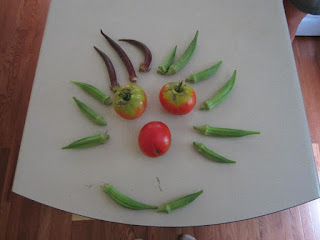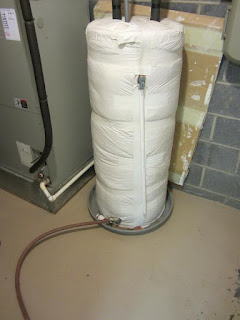This is our first year of really bringing in the harvest from our own garden. In years past we grew enough to sustain our family with fresh vegetables throughout the summer with a little excess to can and give to friends. This year however with a different growing climate and a lot more space, we are really bringing in the harvest with plenty of leftovers for friends. Jon is thrilled to finally grow melons and bring a 5 gallon bucket full of produce to me in the kitchen! So far I have canned 54 pints and 11 quarts of pickles, in addition to 2 gallons of refrigerator pickles! After all that we are still picking more cucumbers and Jon continues to bring grocery sacks full of them to work. We are so cucumbered-out that I do not remorse over the dozen or so that we find that have already yellowed. The chickens have had their full and barely touch any that we leave in their presence. Needless to say, only one cucumber plant will be grown next year...
The Garden Has Turned Into a Jungle!
Labels: Garden
Queen Bee Has Tight Boundaries
So...after introducing the 2nd nuc of bees in early June, I have performed 2 hive inspections to make sure this queen is healthy and laying eggs. Both inspections confirmed that she is indeed alive and laying, but the problem is, she is only laying on the original 4 frames that came from the nuc! There are empty frames of drawn comb next to her, but she refuses to lay eggs in them!
At first glance when opening the hive, one would assume that all is well because the bee population is in fact really large and they are filling out frames with comb, etc. When digging a little deeper, you will notice drawn frames with no eggs and larvae but 4 frames packed to the edges with capped brood, pollen, and nectar. It's almost like the queen works really hard and then takes a vacation until the cells are empty. This discovery after 2 months is a bit unnerving for a beekeeper. I did notice 2 uncapped queen cells which could indicate a replacement queen, but I have been told that most hives keep a queen cell around as a warning to the queen...
I don't know if there is anything a beekeeper can do to encourage expansion. I thought I could switch frames around but I have always been told that this a no-no. Thoughts anyone?
Sorry, no pictures for this post.
Labels: Bees
Homemade Lincoln Log House
After a few weeks mulling over storage ideas, I came up with a giant Lincoln Log House to store all the pieces in!
Labels: Toys , Woodworking
One Week Without Electricity
Hello Readers! You may have noticed that I have missed my weekly posting; and for good reason...we had no electricity! A derecho storm blew through much of the Appalachian area on June 29th and left hundreds of thousands without electricity and some without water. Thankfully we still had water. I describe in detail how we coped during this power outage. Many of the things mentioned below we do on a normal and semi-normal basis to be resourceful with our electricity usage.
Refrigerator/Freezer:
This had to be the most stressful part of losing electricity. In general we keep our refrigerator and freezer moderately full and only open it on an as-needed basis. We don't just have a hankering for a snack and stand with the refrigerator door open for minutes while deciding what to eat. When the power went out, we only opened the refrigerator 4 times in 2 days. By day 3, the milk was just starting to cool off. By the end of day 2, all of the leftovers were gone in the refrigerator so we began eating items in the freezer. At the end of day 2, all of the meat was still frozen solid. The homemade ice cream had turned to liquid but was still very cold and actually hurt my teeth when I drank it. Halfway through day 3, a friend of ours had received electricity, so we packed up the remaining items in the freezer and refrigerator (including condiments) and kept them at her house. With a small cooler and reusable ice packs, we brought items home to eat for the rest of the week. I think the meat would have lasted until day 5. The only items I ended up tossing in the woods because I was unsure if they were safe to eat was a half jar of spaghetti sauce, an open container of soy milk, and a half jar of mayonaise.
Keeping the House Cool:
We seldom use air conditioning; in fact, we have only used it 3 days all summer, and that was Memorial Day weekend when we had friends visiting to replace the barn roof. While the temps have been in the 90's outside this past week, our downstairs never went above 80 and the upstairs above 85. What did we do? At night we opened all of the upstairs windows and a few downstairs that are safe to leave open in case of a prowler. At 6am when I woke up, I opened up all the downstairs windows if it was cooler outside than it was inside; and by 7, all of the windows were closed. A blanket was draped over one of the south-facing upstairs windows to keep the sunlight out and another window had its curtains closed. Just like the refrigerator, we only open the outside door unless we need to and we consolidate our trips outside. The basement was probably another 5-10 degrees cooler but we didn't spend much time down there because that would require flashlights and batteries. By 10 am we were usually done with all of our outside chores and would sit in the cool house for the rest of the day.
Hot Water:
This probably was easily solved...use a garden hose. We have 3, lead-free garden hoses strung across our yard to water the garden; and when filled with water all day long, the water is literally scalding by noon on a clear day. We used the sun's energy to heat the water and enjoyed a gentle breeze while watching the bees pollinate the clover in the yard. We used my homemade castile soap and had a fun time spraying each other with the hose. The hostas behind us also appreciated the drink. This is something even town residents could do...just wear a bathing suit! For washing dishes we heated a pot of water over the fire when we cooked our food.
Cooking Food:
This was a no-brainer since we go camping. We have a small fire pit in the backyard so we cooked all of our meals with fallen dead branches that fell in the storm. To reheat leftovers the first 2 days, we used our solar food dehydrator. As far as having enough food, our pantry is more than stocked.
Overall, going without electricity for a week wasn't that bad for us. If we were like some people without electricity and water, then I'm sure this post would be a bit different. The thought of not having water made me realize that when our well is fixed, we should make sure that it can manually be pumped in case of a power outage.
Throughout the week we heard generators running at the neighbor's houses and couldn't help but wonder how efficient they were, what they were mainly used for (refrigerator vs. hot water vs. computer, etc.), and how much it cost, not to mention the environmental footprint they make. Jon and I don't have any intentions on getting a generator because we managed just fine without one. If it were winter, our fireplace would provide heat; not to mention we kept our house at 34 degrees while living in Laramie, WY for a year when we were poor college kids. I think a little bit of sacrifice is good for everybody. Plus, who wants to wait in line at the gas stations who had electricity...some of those gas station lines were literally a mile long with traffic controllers; and they limited usage to $20.00 per stop!
At the end of the 3rd day, the water heater no longer gave us warm water. We took this opportunity to empty the water out of the water heater to get all of the sediment out. It is recommended that a house does this once each year. From the picture below you can see all of the sandy-looking stuff that came out.
In one week, the garden exploded with ripe produce: beans, cucumbers, zucchinis, and beats. Just when I had all of the canning supplies packed in boxes and ready to take to my friend's house to process, we received electricity! I was relieved to do this at home; but it did get me thinking more about expanding our food drying and cellar options. Now that we have a basement and land to construct a cellar, I would like to look into this more.
On a side note, one thing that did happen during this week was 3 bottles of Perry (sparkling pear cider) blew off their corks!! We think they are still carbonating which we expected would happen since we had to bottle them early because of the unexpected move across country. It was a bit of a mess down in the basement...imagine cleaning up the mess on the floor using a flashlight.
Labels: Conservation






















